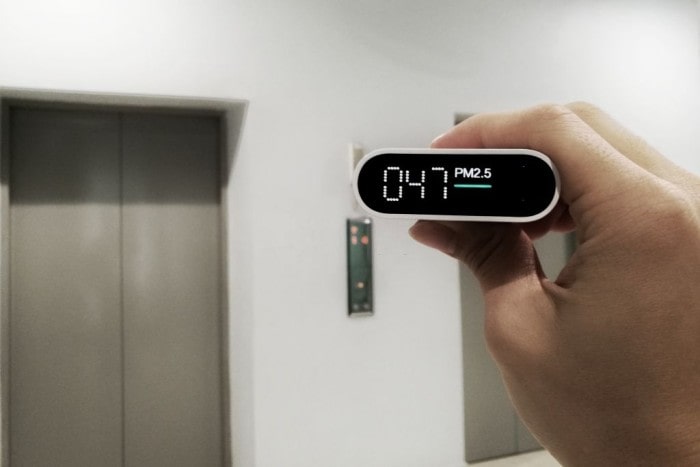
Humans in modern society are indoors 90% of the time, according to the US Environmental Protection Agency. However, indoor air is 2 to 5 times more polluted than outdoor air in most cases, and this poses a health hazard. The ASHRAE Standard 62.2 provides design guidelines to achieve indoor air quality in residential buildings, and the latest version was published in 2019. ASHRAE has also published specific guidance for the coronavirus outbreak – the population stays home for more time, and indoor air quality becomes even more important.
Since outdoor air is cleaner than indoor air, on average, many design guidelines from ASHRAE focus on effective ventilation. A continuous supply of fresh air dilutes pollutant substances, improving indoor air quality. Common sources of air pollution include human activity and many construction materials, especially if they are new. Paints and new wood furniture are notorious for their high chemical emissions.
Indoor air quality makes buildings healthier, but providing comfort is also important. ASHRAE has found that most occupants are comfortable with temperatures of 68-77°F (20-25°C), and a relative humidity of 40-60%. Individual preferences may vary, but most occupants are comfortable with these conditions.
Why Modern Homes Have an Airtight Design
Fresh outdoor air is beneficial for indoor air quality. However, an excessive amount of outdoor air has a negative impact on energy efficiency:
- If cold outdoor air is constantly leaking in during winter, space heating systems must work harder to compensate.
- The same applies during summer: if warm air leaks into the building all the time, air conditioners must use more electricity.
To make heating and cooling more efficient, modern homes are designed with airtight envelopes that reduce air leakage. The outdoor air supply is controlled by a mechanical ventilation system, avoiding unwanted air exchange between the interior and exterior. However, natural ventilation with open windows may be accepted by local authorities, based on climate conditions. When this is the case, building codes will specify natural ventilation as an option.
Indoor air is more polluted on average, but there are times when outdoor air can be harmful. For example, outdoor air has a high pollen content during the flowering season of plants, and many people are allergic. Outdoor air can also become very polluted during high-traffic hours, and building owners may prefer to keep the windows shut. On the other hand, air provided by a mechanical ventilation system can be filtered properly.
Using Extractor Fans in High-Polluting Areas of Homes
ASHRAE recommends extractor fans in rooms that produce large amounts of air pollutants, especially kitchens and bathrooms. This removes air pollution at the source, before it can spread to other areas of the home.
When extractor fans are used intermittently, ASHRAE recommends a minimum airflow of 50 cubic feet per minute (cfm) for bathrooms and 100 cfm for kitchen range hoods. In kitchens that use another type of exhaust system, the required airflow is 300 cfm. On the other hand, when extractors operate continuously, the minimum airflow is 20 cfm in bathrooms and 5 air changes per hour in kitchens.
Ventilation systems are normally designed to recirculate some indoor air, which is mixed with fresh outdoor air. However, since kitchens and bathrooms release pollutants and odors in larger amounts, their air should not be recirculated. ASHRAE Standard 62.2 specifies a minimum filter rating of MERV 11 for recirculated air.
ASHRAE Guidance for COVID-19 Prevention
In response to the coronavirus pandemic, ASHRAE has published specific guidance for all building types, including homes and apartment buildings. The main recommendations are summarized below:
- Exhaust fans like those in kitchens and bathrooms should be used continuously, even if they run intermittently under normal conditions.
- Air filters should be upgraded to MERV 14 or better, instead of the MERV 11 rating that is normally recommended.
- Enhanced filtering can be complemented with an air purifier that uses ultraviolet germicidal irradiation (UVGI).
High efficiency particulate air filters (HEPA) are even more effective than filters with MERV ratings, but many ventilation systems cannot overcome the air resistance they produce. However, HEPA filters are available as portable air cleaners, and some models combine HEPA and UVGI in the same device.
Multifamily buildings require more prevention measures for COVID-19, since they have common areas. Social distancing and face coverings are recommended, just like in commercial buildings. For additional protection, ventilation systems should be reconfigured to avoid air exchange between different apartments.
Author Bio:
Michael Tobias is the founder and principal of Nearby Engineers and New York Engineers, an Inc 5000 Fastest Growing Company in America. He leads a team of more than 30 mechanical, electrical, plumbing, and fire protection engineers from the company headquarters in New York City, and has led numerous projects in New York, New Jersey, Chicago, Pennsylvania, Connecticut, Florida, Maryland, and California, as well as Singapore and Malaysia. He specializes in sustainable building technology and is a member of the U.S. Green Building Council.
